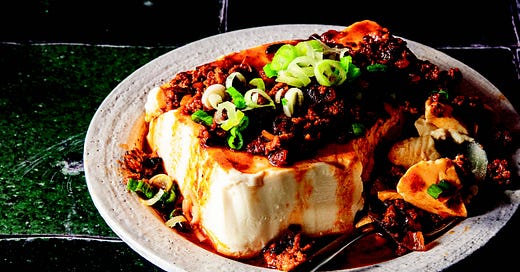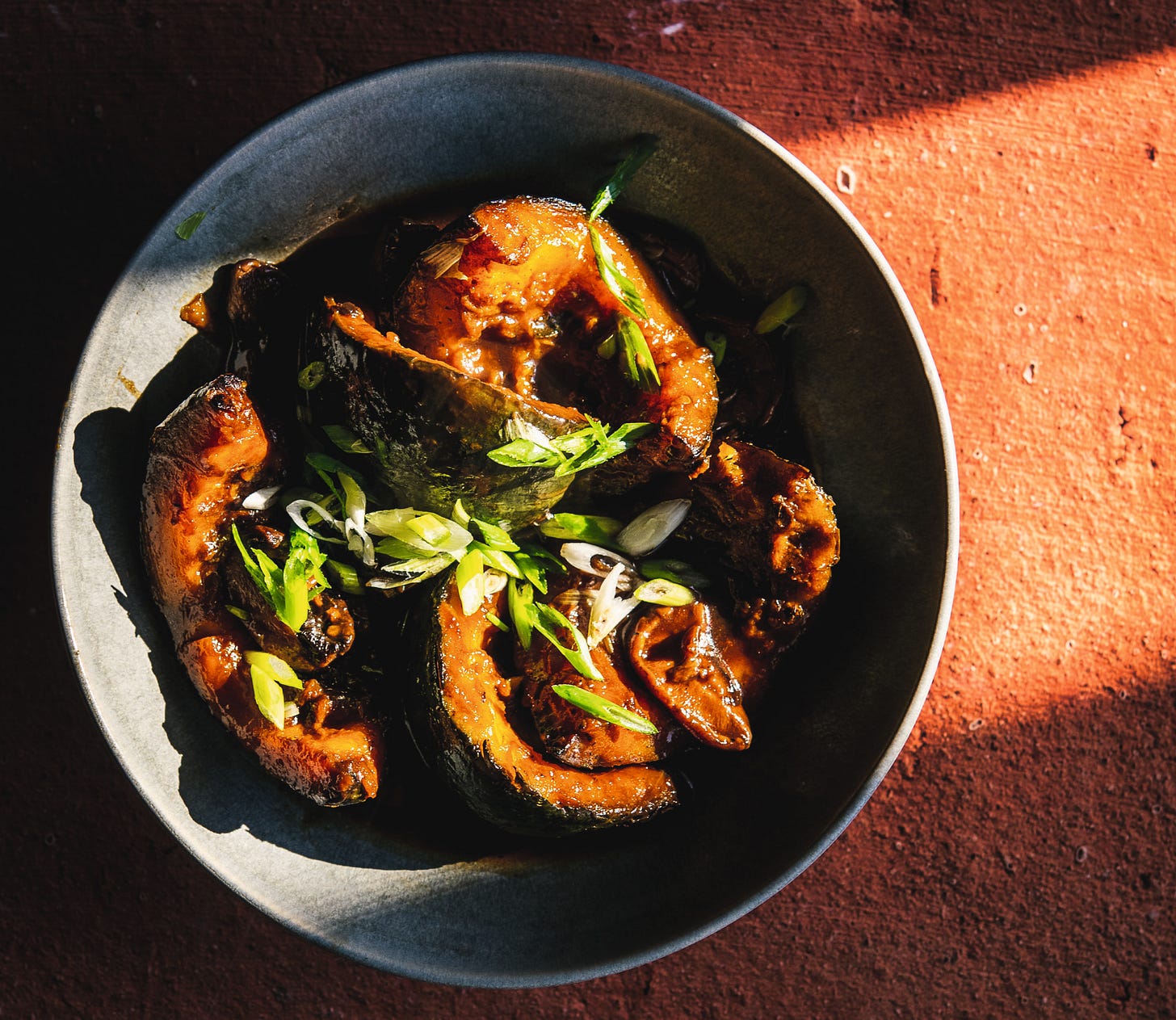Betty Liu’s crispy chorizo over silken tofu
And more of the recipes the cookbook author makes over and over.
Hi friends,
I cannot tell you how excited I am to share the very first episode of The Dinner Plan podcast with you. Each week, I’ll welcome a new guest to chat about what they’re cooking and where they look for dinner inspiration.
This newsletter is where you’ll get easy access to their recommendations—and a full recipe or two reprinted from their newest cookbook.
I’ve been a fan of this week’s guest since I first started cooking from her debut cookbook, My Shanghai, in 2021. (Do not miss her recipe for garlicky flowering chives with pork.) So I was thrilled to see a new release from Betty Liu out this week: The Chinese Way: Classic Techniques, Fresh Flavors.
Organized by cooking technique, the book demonstrates how methods like steaming, braising, stir-frying, and infusing can be applied to both foundational Chinese recipes and newer dishes using “a mishmash of traditional and modern tools and ingredients.”
There’s steamed eggplant with tamarind vinaigrette, fried farro with lap cheong and a touch of smoked paprika, red-braised kabocha squash, and sweet-and-sour mushrooms made with raspberry jam in place of hawthorn fruit.
“The way I cook Chinese food every day,” Betty writes, is “not traditional, but it is Chinese…In fact, incorporating local produce and flavors while using traditional techniques is the essence of Chinese regional cooking.”
On this first-ever episode of The Dinner Plan, we talk about how she fits cooking into her busy life as a surgical resident and parent—and how she makes her favorite flavor-packed sauce for simple greens. I hope you like it!
Cookbook cheat sheet
Tenderheart by Hetty McKinnon
Aloha Kitchen by Alana Kysar
Six Seasons by Joshua McFadden
Book purchase links are affiliate links—an easy way to support the podcast and this free newsletter.
Recipes on our minds
Betty also shares some of her go-to dinners—the beloved meals that have earned a spot in her (busy) regular rotation.
Some dishes, like a rice-cooker dinner with tinned fish, are found in her new book, which you can pick up here. She also loves Hetty McKinnon’s Mushroom Pasta Stir-Fry (NY Times) and Alana Kysar’s Butter Mochi (from Aloha Kitchen, excerpted on Epicurious).
We both suggest dinner plans for a listener who called in with a list of fridge contents. Here’s the recipe I mentioned:
Elena’s Roasted Broccoli With Olive and Almond Pesto (from Salad Pizza Wine, adapted on Saveur.)
Scroll down for the full recipes for two more favorites: Crispy Chorizo and Tomato Over Silken Tofu and Red-Braised Kabocha Squash, kindly excerpted from The Chinese Way.
Crispy Chorizo and Tomato Over Silken Tofu
by Betty Liu, excerpted from The Chinese Way: Classic Techniques, Fresh Flavors. Copyright © 2024 by Betty Liu. Used with permission of Voracious, an imprint of Little, Brown and Company. New York, NY. All rights reserved.
Serves 4
Silken tofu is almost like a savory pudding and so makes a great recipe base. Traditional Chinese recipes involve topping a block of the silken tofu with a soy-based sauce and preserved thousand-year eggs, or just soy sauce and scallions. In Japan, hiyayakko (cold tofu) is garnished with shiso and served chilled, a refreshing dish for warm days. In this recipe, I heap crispy ground chorizo, bathed in a gravy made from caramelized tomato paste, over the chilled silken tofu. The dish features contrasting textures and flavors: crispy versus silky and spicy versus creamy.
1 block (1 pound/455 g) silken tofu
1 tablespoon neutral oil, such as canola or grapeseed, plus more as necessary
6 ounces (170 g) ground Mexican chorizo
1 shallot, thinly sliced
2 garlic cloves, minced
1 tablespoon double-concentrate tomato paste
¼ cup (60 g) unsalted chicken stock or water
1 tablespoon light soy sauce
2 teaspoons light brown sugar
Kosher salt and freshly ground black pepper
2 scallions, trimmed and thinly sliced
Cooked white rice
Line a plate with paper towels, then gently invert the silken tofu block onto the towels and let drain for 5 minutes.
Meanwhile, heat the oil in a large skillet over medium-high heat. Add the ground chorizo and, using a spatula, flatten it in the pan. Let cook undisturbed until crispy, 2 to 3 minutes.
Use the spatula to turn the chorizo and crisp the other side, 2 to 3 minutes. Break it up into bite-sized, crispy pieces. With the spatula or a slotted spoon, transfer the chorizo to a small bowl and set aside.
There should be rendered fat in the pan, but if it’s dry, add a splash of oil. Add the shallot and garlic, reduce the heat to medium, and sauté until softened and beginning to brown, 3 to 4 minutes.
Add the tomato paste and stir to coat the alliums. Cook, stirring frequently, until the paste has darkened and caramelized, about 5 minutes.
Stir in the stock or water, soy sauce, and brown sugar and mix to combine. Return the chorizo to the pan. Simmer for 2 to 3 minutes to meld the sauce and chorizo. Season with salt and black pepper to taste.
Place the tofu gently on a serving plate and top with the tomato-chorizo sauce. Sprinkle with the scallions. Spoon over rice to serve.
Red-Braised Kabocha Squash
by Betty Liu, excerpted from The Chinese Way: Classic Techniques, Fresh Flavors. Copyright © 2024 by Betty Liu. Used with permission of Voracious, an imprint of Little, Brown and Company. New York, NY. All rights reserved.
Serves 4
Come autumn, I, like many other West-to-East-Coast transplants, rush to the store for the gorgeous varieties of squash: delicata, honeynut, acorn, kabocha. The sturdy, squat kabocha squash is a favorite of mine—its thick skin hides an earthy, sweet orange flesh. In this recipe, wedges of kabocha are cooked with the traditional 红烧 hóng shao, red-braise method: the squash is browned in hot melted sugar, then braised in a liquid seasoned with soy sauce, sugar, and rice wine.
NOTE: Make sure to cut the kabocha wedges of equal thickness so they cook evenly.
2 tablespoons neutral oil
2 tablespoons coarsely crushed rock sugar, divided
1½ pounds (680 g) kabocha squash (about 1 small), washed well, seeded, and cut into 2-inch-thick wedges
4 ounces (115 g) fresh shiitake mushrooms, stemmed and halved
4 ounces (115 g) cremini mushrooms, stemmed and halved
4 scallions, trimmed and roughly chopped
Two ¼-inch-thick slices ginger
2 garlic cloves, peeled and smashed
1½ cups (360 g) water, plus more as necessary
2 tablespoons Shaoxing wine
2 tablespoons light soy sauce
1 teaspoon dark soy sauce
1 piece star anise
1 teaspoon cornstarch mixed with 1 tablespoon water
2 tablespoons unsalted butter
1 scallion, trimmed and thinly sliced crosswise (optional)
Heat the oil in a wok or large heavy-bottomed skillet over low heat. Sprinkle in 1 tablespoon of the crushed rock sugar and stir to dissolve.
Working in batches, lay the kabocha wedges, cut side down, in the sugary oil in a single layer and cook undisturbed until browned, 6 to 8 minutes. Turn and brown the other side. Transfer the kabocha to a plate.
Add a splash of oil if the pan is dry, and add the shiitake mushrooms and cremini mushrooms. Stir-fry until browned, about 6 minutes, then transfer to a small bowl.
Add another splash of oil if the pan is dry, and add the scallions, ginger, and garlic and stir-fry until fragrant, about 1 minute.
Return the kabocha to the pan and arrange in one layer. Add the water, Shaoxing wine, light soy sauce, dark soy sauce, the remaining 1 tablespoon rock sugar, and the star anise. The liquid should come halfway up the wedges; add a bit more water if necessary. Bring to a boil, then reduce the heat to medium-low. Cover partially with a lid and simmer gently until the squash is tender but not falling apart, 8 to 10 minutes.
Uncover and turn the squash pieces. If the squash is already fully tender, carefully remove it from the pan and set aside. Add the mushrooms to the braising liquid. Cover, and cook for another 3 minutes, until the squash is tender or the liquid has thickened.
Increase the heat to high and cook until the liquid has reduced by half, about 5 minutes. Gently stir in the cornstarch slurry and cook until the liquid reaches a gravy-like consistency, coating the back of a spoon, 1 to 2 minutes.
Add the butter and stir gently to create a silky sauce. Return the kabocha wedges to the sauce, garnish with the sliced scallion (if using), and serve.
SUBSTITUTE: If you can’t find kabocha, you can use other squashes—just remember some squash will be done sooner than others. Delicata, for example, is thinner and will cook more quickly.







Thank you for having me! Loved both episodes!
That looks amazing